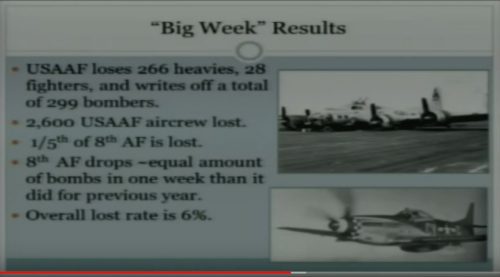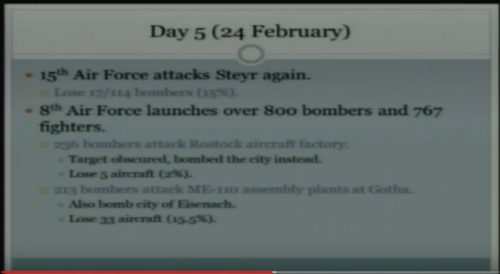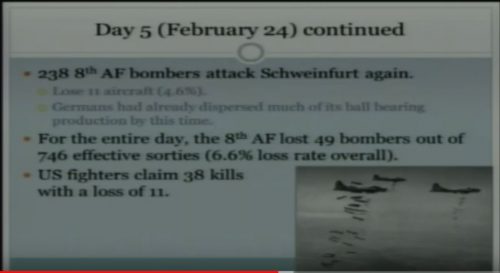In our complete avoidance of what is being offered in the way of American-produced broadcast and cable TV series, the Daughter Unit and I are ransacking the various streaming services for serial diversion of an evening: series old and new, new to us, or perhaps something old, something that we vaguely recall watching a good while ago and thought that it was worth another round. Last week our choice hit on the 1979 series Danger UXB which came out the year before my daughter was born and featured a practically teen-aged-appearing Anthony Andrews. (Although he was nearly thirty at the time and seemed to be almost ubiquitous in those British TV series which appeared on Masterpiece Theater in that era. The Daughter Unit loved the 1982 version of the Scarlet Pimpernel, where he co-starred with Jane Seymour. She practically wore my copy of that series on videotape to bits.)
War and Peace
The June 1944 Normandy Invasion and the Bane of Technologically Illiterate Military Leaders in the Luftwaffe
This blog post on “The June 1944 Normandy Invasion and the Bane of Technologically Illiterate Officers in the Luftwaffe” marks the second in a series of posts departing from past history columns I’ve written for Chicagoboyz in that it is exploring a theme I refer to as “The Bane of Technologically Illiterate Military Leaders.”[1] .
The issue with ‘Technologically Illiterate Military Leaders‘ I’ll be exploring in this and future articles is that such leaders tend to make the same classes of mistakes over and over again. And when those military leaders reach flag rank on the bones of theories and doctrines that fail the test of combat through their technological illiteracy. They then bury the real reasons why those doctrines failed behind walls of jargon and classification to avoid accountability for those failures.
In this particular case, the mistake is how the otherwise technically competent Luftwaffe Funkaufklärungsdienst (Roughly translated — Electronic Intelligence Early Warning Service) managed to miss a completely unambiguous invasion warning for the Normandy Invasion — D-Day, June 6th 1944 — the night before the invasion.
This happened because the German officers over the Luftwaffe technicians were technologically illiterate regards both the Allied identification friend or foe (IFF) and Allied radio navigation systems they were monitoring, as well as the radar techniques their own Luftnachrichten Dienat (Air Surveillance Service) were using to track RAF Bomber Command night bomber streams through chaff.

.
Electronic warfare is much like mine sweeping/hunting at sea, or combat engineers breaching a minefield on land, in that it is a thankless job when it is done right and “hard” on military officers careers in exercises/planning. Thus it tends to be avoided, even when it is central to recorded military history. Case in point — When Stephen L. McFarland wrote “Conquering the Night: Army Air Forces Night Fighters at War” in the late 1990’s (pub date 1998) as a part of “AIR FORCE HISTORY AND MUSEUMS PROGRAM.” He completely left out the fact that German bomber tail warning radars were picking up Allied night fighter IFF challenges. This was a fact that Alfred Price had published fourteen years earlier in 1984!
The “After Big Week” Assessment, plus 75 years
Today marks the 75th Anniversary of the completion of Operation Argument otherwise known as BIG WEEK. The strategic goals of the operation were to destroy German fighter production and inflict a “wastage” rate of the German fighter force such that it was losing fighter planes faster than it was producing them. In measurements of this objective. In the initial assessments of the BIG WEEK bombing, 8th Air Force thought they had done that. Actually, this was as wildly optimistic as the claims of air to air kills by the heavy bomber crew machine gunners.
.
Despite destroying 70% of the German fighter aircraft assembly buildings targeted. The USAAF high command had grossly underestimated damage done to electric motor powered machine tools within those buildings and the UK’s Ministry of Economic Warfare that the USAAF relied upon for intelligence of German industry had underestimated German fighter production by a factor of 2 & 1/2 times.
See my Jan 1, 2019 Chicagoboyz post “Industrial Electrification and the Technological Illiteracy of the US Army Air Corps Tactical School 1920-1940” for many of the reasons why this was so.

The 8th Air Force lost 565 heavy bombers shot down or scrapped from combat damage so bad it was not worth the effort to repair them. 8th and 9th Air Force fighters escorting the bombers suffered 28 planes shot down. The over all loss rate per raid averaged 6%…but the American total force losses were 2,600 air crew killed, wounded or captured. This was 1/5th of 8th Air Force.
Big Week, Day 5, Feb 24, 1944, Plus 75 Years


Missions 237, 238 and 239 are flown against targets in France; 7 B-17s are lost. Heavy clouds cause over half the bombers dispatched to return without bombing..Mission 237: 49 of 81 B-24s hit the Ecalles sur Buchy V-weapon sites; 1 B-24 is damaged. Escort is provided by 61 P-47s.Mission 238: 258 B-17s are dispatched against V-weapon sites in the Pas de Calais; 109 hit the primary target, 10 hit a road junction E of Yerville, 7 hit a rail siding SW of Abbeville and 6 hit targets of opportunity; 7 B-17s are lost and 75 damaged; casualties are 5 WIA and 63 MIA. Escort is provided by 81 P-38s, 94 P-47s and 22 P-51s; 1 P-38 is damaged beyond repair; the P-51s claim a single German aircraft on the ground..Mission 239: 5 of 5 B-17s drop 250 bundles of leaflets[clarification needed] on Amiens, Rennes, Paris, Rouen and Le Mans, France at 20232055 hours without loss.
Bomber Command directly contributed to the attacks on the aircraft industry in Schweinfurt. Some 734 bombers were dispatched on the night of 24/25 February, and 695 struck the target.[1] Of the bombs dropped, 298 hit within three miles and 22 hit inside the target area. Little damage was done.
.
For extensive background, see this Wikipedia article, where the passage above came from:
In July, when a bomber group took over Horsham Saint Faith, Zemke’s men relocated to a half-built base at Halesworth Suffolk. Upset with the second-rate treatment his command seemed to be experiencing, Zemke joined a group of Eighth Air Force bomber commanders in a gripe session. The 4th Bomb Wing’s Colonel Curtis LeMay (chief of the postwar Strategic Air Command) complained that the only fighters he had seen so far ‘all had black and white crosses on them,’ but declared his bombers would carry on ‘with or without fighter escort.’
.
Later, in the officers’ club, another bomber general stated he ‘wouldn’t pay a dime a dozen for any fighter pilots.’ Zemke hurled his pocket change at the man’s feet:
.
‘Here, General, this is all I have handy at the moment,’ he responded. ‘Any time you have a couple dozen fighter pilots handy send them my way. We can sure use them.’ Then he jumped in his Jug and buzzed the place.
Big Week, Day 4 Feb 23, 1944, Plus 75 Years
Today marks the 75th Anniversary of the fourth day of Operation Argument otherwise known as BIG WEEK. On Wednesday, February 23, 1944 the 15th Air Force went after the Luftwaffe in the skies over Germany — with the 8th Air Force operations grounded by fog — in the battle for air superiority before the Normandy invasion scheduled for June 1944.
Like the previous day, the 15th Air Force lacked fighter escorts.

ETO Strategic Operations
Mission 232: 5 of 5 B-17s drop 250 bundles of leaflets on Rennes, Le Mans, Chartres, Lille and Orleans, France at 21:3622:32 hours without loss.
MTO Strategic Operations
B-24s bomb the industrial complex at Steyr, Austria. Other heavy bombers are forced to abort because of bad weather; the bombers and escorting fighters claim 30+ aircraft shot down.
For extensive background, see this Wikipedia article, where the passage above came from:
https://en.wikipedia.org/wiki/Big_Week
From the Pre-War “Conveyor-Protector” to Long Range Escort Fighters
One of the most troubling parts of the US Army Air Force “P-51 Narrative” that the “Bomber Generals” pushed after “Big Week” was that the USAAF had learned nothing from the 1940 “Battle of Britain” about the need for fighter escorts.
It turns out that the US Army Air Corps had not missed that obvious point at all. They utterly got that point. In fact, tab #4 for the AAF’s first Air War Plan (AWPD-1) written in August 1941 called for specialized escort fighters. See this link from Ryan Crierie’s web site —
http://alternatewars.com/WW2/VictoryPlan/Air_Force_Requirements.htm
What they did with that insight was utterly squandered by the factional politics of the “Bomber Mafia” between 1940 and the failure of the second Schweinfurt raid on 14 October 1943.
The need to avoid accountability for that failure — like hiding the real range of the P-47D with 150 gallon drop tanks after “Big Week” — was why this institutional lie was told. The motive being to preserve the reputations of General H. H, “Hap” Arnold and a lot of Bomber Generals who founded the independent US Air Force.
And like any other claims of conspiracy in high places, great claims require great big heaping piles of evidence that they are true. In July 2017 my research partner found the official memorandum chain that constitutes that great big heaping piles of evidence. (See appendices one thru four at the end of this post)
This is how Ryan described this official memorandum chain to me:
I found a memorandum chain in a folder today at NARA titled unconventional escort fighters“, which was full of stuff like the XP-85 Goblin parasite, and a few gems like early consideration of the Northrop XP-79 as a parasite fighter, but at the end of the folder was some stuff circa September 1941 on Long Range Bomber Escort.
.Basically, blah blah, European war experience shows the need for longer range fighters; and it suggested a bunch of studies be done on various heavy bombardment aircraft to turn them into convoy escorts — the beginning of the XB-40/XB-41 program — and they suggested that the B-29 and B-32 be studied as convoy escorts..They also suggested studying aircraft like the XP-67, XP-58, and XA-26 with an interest towards making a fighter with extreme range.
You all can go read the memo chain below, but a short form is as follows —